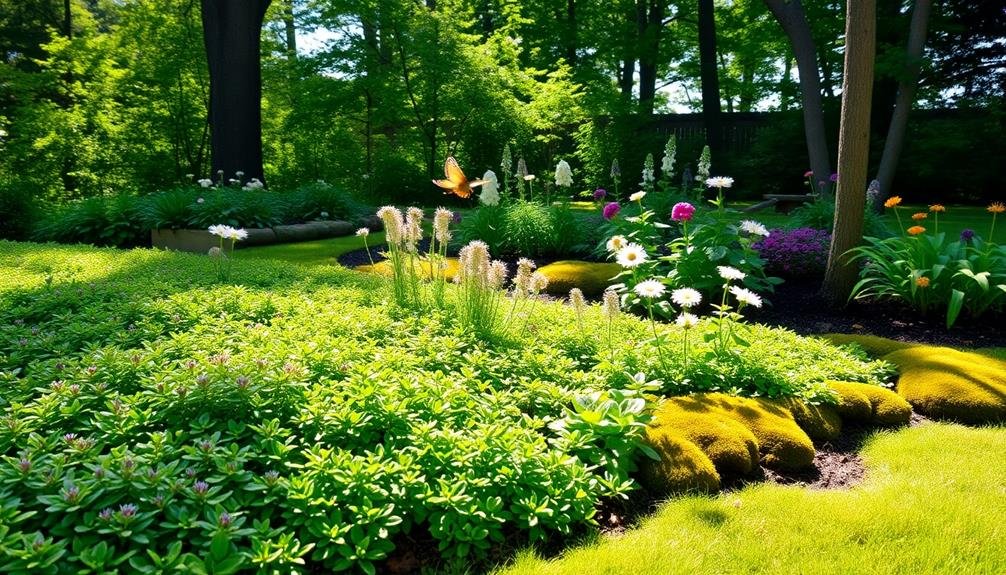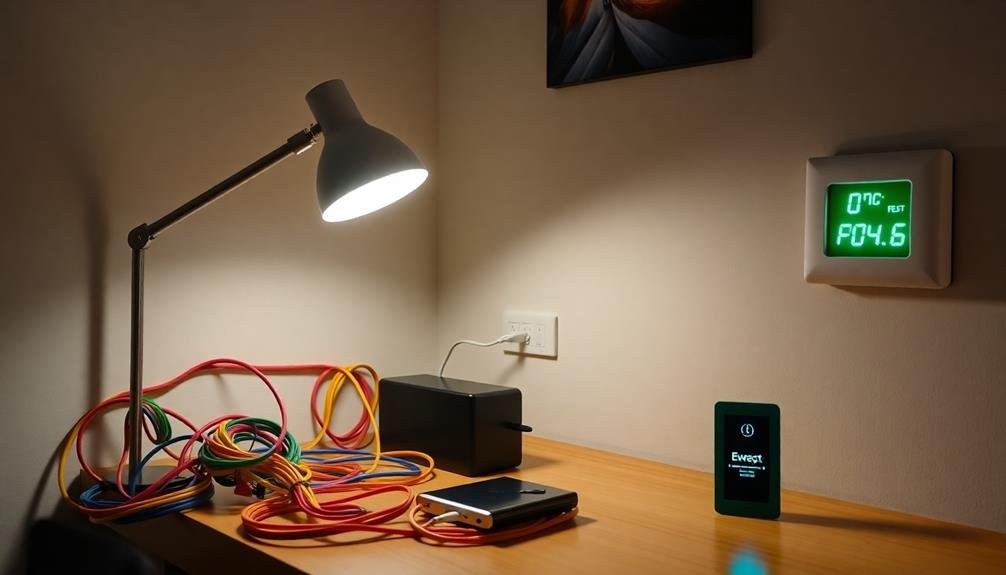For an energy-efficient yard, consider these seven ground covers: creeping thyme, sedum, clover, moss, ajuga, creeping juniper, and ornamental grasses. These low-maintenance options reduce water usage by up to 50% compared to traditional lawns. They're drought-tolerant, suppress weeds, and require minimal mowing. Creeping thyme and sedum thrive in sunny areas, while moss is perfect for shade. Clover improves soil quality naturally, and ajuga offers colorful foliage. Creeping juniper provides year-round coverage, and ornamental grasses add texture and movement. By choosing these ground covers, you'll create a beautiful, sustainable landscape that saves time, water, and energy. Discover how each option can transform your yard into an eco-friendly oasis.
Creeping Thyme

A carpet of fragrant, purple blooms awaits you with creeping thyme. This low-growing perennial is an excellent choice for energy-efficient yards, offering both beauty and functionality.
You'll appreciate its drought-tolerant nature, which means less watering and maintenance. Creeping thyme thrives in full sun to partial shade, making it versatile for various garden locations.
As a ground cover, it spreads quickly, forming a dense mat that suppresses weeds and reduces the need for chemical herbicides. Its shallow root system helps prevent soil erosion, while its dense foliage acts as a natural insulator, keeping the soil cool in summer and warm in winter.
This temperature regulation can lead to reduced energy costs for your home.
You'll love how creeping thyme attracts pollinators like bees and butterflies, enhancing your garden's biodiversity. It's also deer-resistant and can withstand light foot traffic, making it ideal for walkways or between stepping stones.
With its aromatic leaves, you can even use it as a culinary herb. Choose from varieties like 'Coccineus' for vibrant red flowers or 'Albus' for white blooms to suit your landscape design.
Sedum
You'll find sedum to be an excellent choice for energy-efficient landscaping due to its drought-tolerant nature and hardiness.
This low-growing ground cover comes in a variety of colorful options, adding visual interest to your yard while requiring minimal maintenance.
Whether you opt for the vibrant 'Dragon's Blood' or the subtle 'Autumn Joy', sedum varieties can withstand harsh conditions and still thrive, making them ideal for eco-conscious gardeners.
Drought-Tolerant and Hardy
Out of all the drought-tolerant ground covers, sedum stands out as one of the hardiest options for energy-efficient yards. You'll find it thrives in various conditions, from full sun to partial shade, making it an ideal choice for diverse landscapes. Sedum's ability to store water in its thick, fleshy leaves allows it to withstand extended periods of drought without compromising its appearance.
When you're planning your energy-efficient yard, consider these sedum varieties and their characteristics:
| Variety | Height | Spread | Flower Color | Bloom Time |
|---|---|---|---|---|
| Sedum acre | 2-3" | 12-18" | Yellow | Summer |
| Sedum album | 4-6" | 12-18" | White | Summer |
| Sedum rupestre | 6-8" | 18-24" | Yellow | Summer |
| Sedum spurium | 4-6" | 18-24" | Pink/Red | Summer |
| Sedum ternatum | 3-4" | 6-12" | White | Spring |
You'll appreciate sedum's low maintenance requirements, as it rarely needs watering once established. Its dense growth habit helps suppress weeds, reducing the need for herbicides and manual weeding. By choosing sedum for your ground cover, you're not only creating an attractive landscape but also conserving water and minimizing energy use in your yard.
Low-Growing Colorful Varieties
While sedum's drought tolerance and hardiness make it a top choice for energy-efficient yards, its low-growing colorful varieties offer an additional aesthetic appeal.
You'll find a wide range of sedum species that provide vibrant hues and interesting textures to your landscape. Sedum spurium, also known as two-row stonecrop, comes in shades of pink, red, and purple, creating a stunning carpet-like effect.
Sedum rupestre 'Angelina' boasts bright golden-yellow foliage that turns amber in fall, adding year-round interest to your yard.
For a pop of blue-green, consider Sedum reflexum 'Blue Spruce', which resembles miniature evergreen trees. If you're looking for dramatic color changes, try Sedum kamtschaticum, which shifts from green to yellow to orange throughout the seasons.
These low-growing sedums typically reach heights of 3-6 inches, making them perfect for rock gardens, borders, and filling in spaces between stepping stones.
They're also excellent choices for green roofs and vertical gardens. By incorporating these colorful sedum varieties, you'll create an energy-efficient yard that's both visually appealing and low-maintenance, requiring minimal watering and upkeep once established.
Clover

Clover offers an excellent low-maintenance alternative to traditional grass lawns.
You'll find it requires less mowing, watering, and fertilizing than typical turfgrass, saving you time and resources.
As a nitrogen-fixing plant, clover also improves soil quality naturally, reducing the need for chemical fertilizers in your yard.
Low-Maintenance Lawn Alternative
Nature's carpet of clover offers a low-maintenance alternative to traditional grass lawns. You'll find that clover requires less water, mowing, and fertilizer than conventional turf. It's also more resistant to pests and diseases, reducing the need for harmful chemicals in your yard.
Clover's nitrogen-fixing properties naturally enrich the soil, eliminating the need for synthetic fertilizers. This eco-friendly ground cover stays green even during dry spells and can withstand moderate foot traffic. You'll appreciate its soft texture and the charming white or pink flowers it produces in spring and summer.
Here's a comparison of clover to traditional lawn grass:
| Feature | Clover | Traditional Grass |
|---|---|---|
| Water needs | Low | High |
| Mowing frequency | 2-3 times per year | Weekly |
| Fertilizer | None needed | Regular |
| Pest resistance | High | Moderate |
| Drought tolerance | Good | Poor |
Nitrogen-Fixing Soil Improver
For years, gardeners have recognized clover as a powerful nitrogen-fixing soil improver. This low-growing ground cover enhances soil fertility naturally, reducing the need for synthetic fertilizers.
You'll find that clover, particularly white clover, thrives in various climates and soil types, making it an excellent choice for energy-efficient yards.
When you incorporate clover into your lawn, you're not just improving soil health. You're also creating a more sustainable and eco-friendly landscape. Clover's deep root system helps prevent soil erosion, while its dense growth crowds out weeds, reducing the need for herbicides.
Here are three key benefits of using clover as a nitrogen-fixing soil improver:
- Reduces lawn maintenance costs by decreasing fertilizer needs
- Supports beneficial insects, including pollinators
- Stays green during drought conditions, requiring less watering
You'll notice that clover-rich lawns remain lush and vibrant with minimal effort. By choosing this nitrogen-fixing ground cover, you're creating a resilient, low-maintenance yard that contributes to overall energy efficiency.
Embrace clover's natural benefits to transform your outdoor space into an eco-conscious haven.
Moss
Moss stands out as a unique and versatile ground cover option for energy-efficient yards. It's low-maintenance, requires no mowing, and thrives in shady areas where grass struggles. You'll find that moss creates a lush, carpet-like appearance that's both visually appealing and environmentally friendly.
When choosing moss for your yard, consider these factors:
| Species | Shade Tolerance | Moisture Needs | Growth Rate | Foot Traffic Tolerance |
|---|---|---|---|---|
| Irish Moss | Partial | Moderate | Slow | Low |
| Sheet Moss | Full | High | Moderate | Moderate |
| Cushion Moss | Partial to Full | Moderate | Slow | Low |
| Fern Moss | Full | High | Fast | Low |
| Rock Cap Moss | Partial to Full | Low | Slow | High |
To establish moss in your yard, you'll need to prepare the soil by removing existing vegetation and ensuring proper pH levels (typically 5.0-6.0). You can propagate moss by transplanting patches or creating a moss slurry to spread over the desired area. Once established, moss requires minimal care, making it an excellent choice for energy-efficient landscaping. It naturally retains moisture, reducing the need for irrigation, and helps prevent soil erosion.
Ajuga

Ajuga, also known as bugleweed, offers another excellent ground cover option for energy-efficient yards. This low-growing perennial spreads quickly, forming a dense mat that suppresses weeds and reduces the need for mowing. Ajuga thrives in both sun and shade, making it versatile for various landscape areas.
Its evergreen foliage provides year-round coverage, while its vibrant blue, purple, or white flowers add a splash of color in spring.
You'll find ajuga particularly useful for:
- Erosion control on slopes and hillsides
- Filling in bare spots under trees or shrubs
- Creating a living mulch around garden beds
Ajuga's drought tolerance makes it an energy-efficient choice, as it requires minimal watering once established. Its dense growth also helps retain soil moisture and regulate ground temperature, reducing the need for supplemental irrigation and cooling in your yard.
You can choose from various cultivars with different leaf colors and textures, allowing you to customize your landscape's appearance. When planting ajuga, space the plants 6-9 inches apart to guarantee quick coverage.
With proper care, you'll enjoy a lush, low-maintenance ground cover that contributes to your yard's energy efficiency.
Creeping Juniper
Spreading across the ground like a living carpet, creeping juniper offers an excellent choice for energy-efficient yards. This evergreen groundcover thrives in full sun and adapts well to various soil types, making it a versatile option for your landscape. You'll appreciate its low-maintenance nature and ability to conserve water, reducing your yard's overall energy consumption.
Creeping juniper comes in several varieties, each with unique characteristics:
| Variety | Height | Spread | Color |
|---|---|---|---|
| Blue Rug | 4-6" | 6-8' | Blue-gray |
| Green Mound | 6-8" | 6-8' | Bright green |
| Golden Carpet | 3-6" | 6-8' | Gold to bronze |
| Wiltonii | 4-6" | 6-8' | Silver-blue |
You'll find creeping juniper particularly useful for erosion control on slopes and as a weed suppressant in large areas. Its dense growth habit helps retain soil moisture and reduces the need for frequent watering. Additionally, this groundcover provides year-round interest with its evergreen foliage and can even produce small, blue berries that attract birds. By incorporating creeping juniper into your yard, you're not only creating an attractive landscape but also contributing to a more energy-efficient outdoor space.
Ornamental Grasses

For those seeking a dynamic and low-maintenance option, ornamental grasses offer an excellent choice for energy-efficient yards. These versatile plants come in various heights, colors, and textures, providing year-round interest and reducing the need for frequent watering or mowing.
You'll find ornamental grasses adapt well to different soil types and climate conditions, making them ideal for diverse landscapes.
When incorporating ornamental grasses into your yard, consider their energy-saving benefits:
- Natural insulation: Taller varieties can act as windbreaks, reducing heating costs in winter.
- Erosion control: Deep root systems help prevent soil erosion and improve water retention.
- Habitat creation: Grasses provide shelter and food for beneficial insects and wildlife, promoting biodiversity.
Popular ornamental grass species include Feather Reed Grass, Blue Fescue, and Switchgrass.
These low-maintenance plants require minimal fertilization and pest control, further reducing your yard's environmental impact. You can use them as borders, focal points, or mass plantings to create visually appealing and energy-efficient landscapes.
Frequently Asked Questions
How Do Ground Covers Affect Soil Erosion and Water Runoff?
Ground covers protect your soil from erosion by anchoring it with their roots. They'll slow water runoff, allowing more time for absorption. You'll see reduced soil loss and improved water retention in your yard.
Can Ground Covers Replace Traditional Lawns Entirely?
Yes, you can replace your traditional lawn entirely with ground covers. They'll provide similar benefits while requiring less maintenance. You'll save water, reduce mowing, and create a unique landscape. Consider your climate and soil when choosing alternatives.
Which Ground Covers Are Best for High-Traffic Areas?
For high-traffic areas, you'll want tough ground covers that can withstand foot traffic. Consider using creeping thyme, clover, or moss. They're durable, low-growing, and can handle some trampling while still looking attractive and staying healthy.
Are There Ground Covers That Repel Pests Naturally?
Yes, you'll find several ground covers that naturally repel pests. Try planting herbs like thyme, mint, or lavender. Chrysanthemums, marigolds, and petunias are also effective. These plants emit scents or compounds that deter various insects and small animals.
How Do Ground Covers Impact Local Wildlife and Biodiversity?
Ground covers can greatly impact local wildlife and biodiversity. You'll find they provide shelter and food for insects, birds, and small mammals. They also help retain soil moisture, prevent erosion, and create diverse habitats in your yard.
In Summary
You've now got a great selection of ground covers to choose from for your energy-efficient yard. These options will help you reduce water usage, minimize maintenance, and create a beautiful, sustainable landscape. Whether you prefer the delicate flowers of creeping thyme or the hardy resilience of sedums, there's a ground cover that'll suit your needs. Don't forget to take into account your climate and soil conditions when making your choice. With these ground covers, you'll be on your way to a more eco-friendly outdoor space.





Leave a Reply